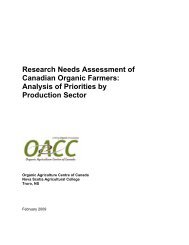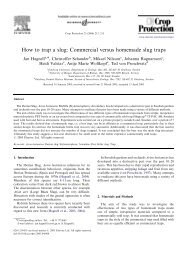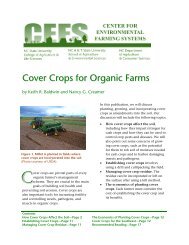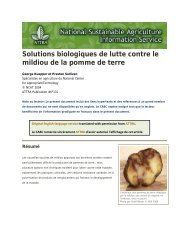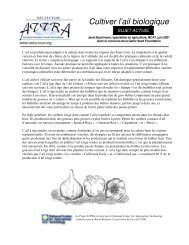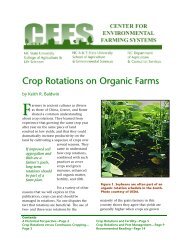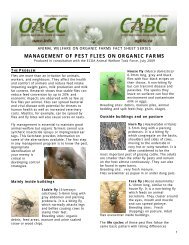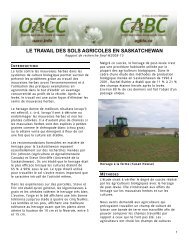Sweet potato: organic production - Centre d'agriculture biologique ...
Sweet potato: organic production - Centre d'agriculture biologique ...
Sweet potato: organic production - Centre d'agriculture biologique ...
Create successful ePaper yourself
Turn your PDF publications into a flip-book with our unique Google optimized e-Paper software.
thuringiensis to discover Cry proteins (from Bt cry genes) that exhibit toxicity to insect pests,including the… sweet<strong>potato</strong> weevil…. Microbial insecticides also are being screened for activityagainst soil insect pests in sweet<strong>potato</strong>es.”www.cgiar.orgRecent research by International Potato Center (CIP) personnel in China has shown that sweet<strong>potato</strong>yield can be increased by as much as 30 to 40% without additional fertilizer, pesticides,or genetic improvement. In a five-year project in the provinces of Anhui andShandong, using a procedure that eliminates viral diseases from planting materials,scientists were able to develop virus-free cuttings that developed into healthy plants.If extended to all of China’s sweet<strong>potato</strong> growing regions, benefits exceeding $1.5 billioncould be realized. This development would considerably reduce the country’s reliance oncereal imports for livestock feed.www.cgiar.orgResearch being funded by Cargill Dow LLC et al. was described in testimony on March 29, 2001, beforethe United States Senate Committee on Agriculture, Nutrition and Forestry by Dr. PatrickR. Gruber, Vice President and Chief Technology Officer of Cargill Dow LLC, as follows:Toyota recently announced that they are entering the “sweet<strong>potato</strong> processing business” in Indonesiawith the intent of producing lactic acid and later on PLA [polylactic acid, used for biodegradableplastics]. They have in their view a biorefinery based on sweet<strong>potato</strong>es. I’m told that they chosesweet<strong>potato</strong>es and location based on carbon fixation yield and efficiency.The document is no longer available on-line.PublicationsGeneralA list of research papers on sweet<strong>potato</strong> as a food resource, at:http://food.oregonstate.edu/ref/plant/sweet_r.htmlCollins, Wanda W. 1993. Root vegetables: New uses for old crops. p. 533–537. In: Jules Janick andJames E. Simon (ed.). New Crops: Exploration, Research, and Commercialization. JohnWiley and Sons, Inc., New York, NY.Organic researchCollins, Wanda W. et al. 1994. Organic nitrogen sources for sweet<strong>potato</strong>es: Production potentialand economic feasibility. SARE/ACE Annual Reports (Project Report LS92-45). p. 45–46.Creamer, N.G., and K.R. Baldwin. 2000. An evaluation of summer cover crops for use in vegetable<strong>production</strong> systems in North Carolina. HortScience, Vol. 35, No. 4. p. 600–603.Seem, Jessica. 2002. Critical Weed-Free Period for ‘Beauregard’ <strong>Sweet</strong><strong>potato</strong> (Ipomoea batatas) andWeed Seedbank Changes in Response to Transitioning from Conventional to Organic FarmingSystems. MS Thesis. North Carolina State University, Greensboro, NC.Seem, J., N.G. Creamer, and D.W. Monks. 2003. Critical weed-free period for ‘Beauregard’ sweet<strong>potato</strong>(Ipomea batatas). Weed Technology. Vol. 17. p. 686–695.ATTRA//SWEETPOTATO ORGANIC PRODUCTION PAGE 13



